A woman hikes up to a sacred spring that she visits at least once a season. From her small bag, she pulls out a beautiful crown of flowers that she had lovingly crafted before leaving home. Placing the crown upon her head, she dances and sings around the spring, drinking deeply and celebrating life on this early fall. As a sign of respect and offering, she hangs the flower garland near the spring and carries her sacred water back down the mountain.
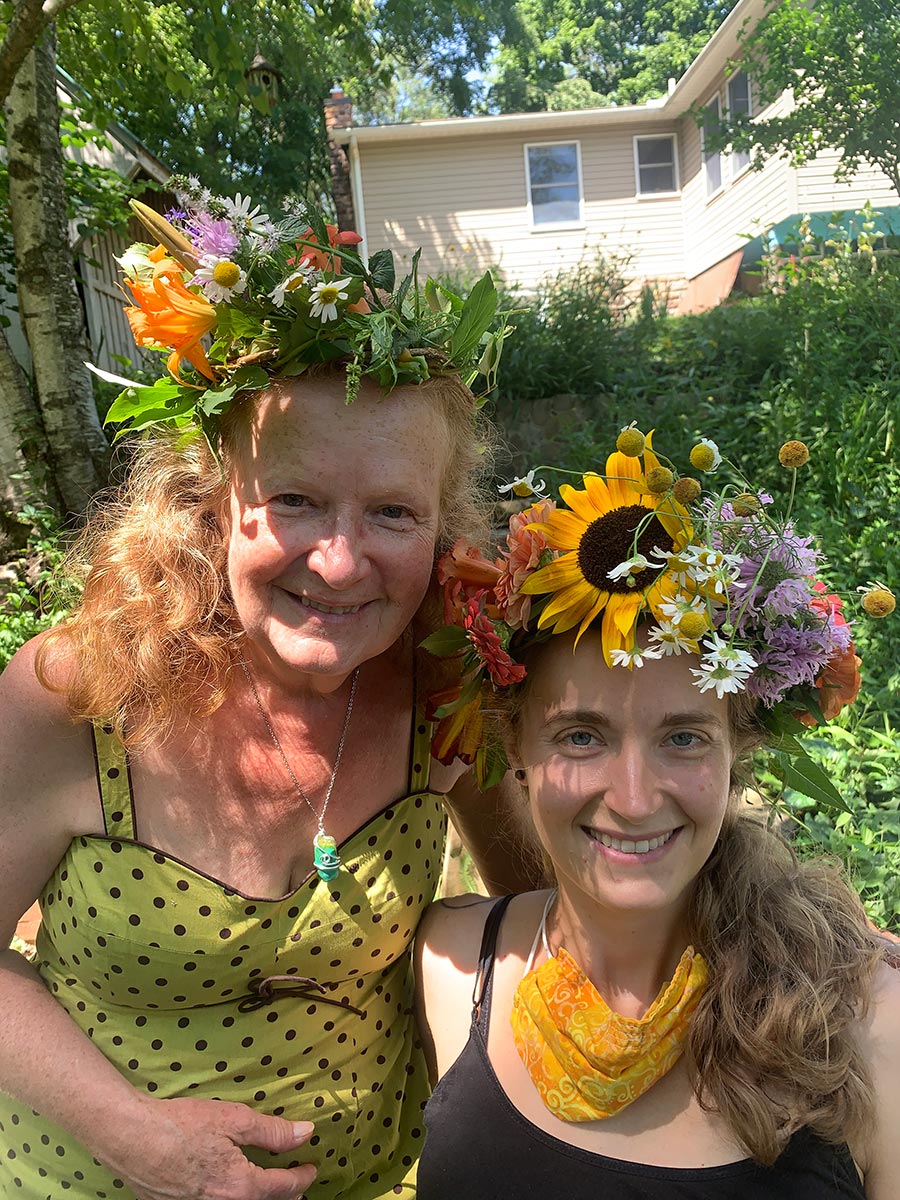
I find it interesting that the ancient art of flower crowns garland making is almost non-existent today, at least here within the US. This tradition has so much potential. The only people who I’ve seen make these delightful crowns are children, who haven’t yet lost their magic or wonder about the world. And yet, garlands and flower crowns, are powerful, expressive, and wonderful to create, to wear, and to offer. I grew interested in learning this practice after I had read about the ancient practice of adoring flower garlands sacred springs with regards to Lughnasadh traditions, and I liked the idea of a flower garland or crown as a potential offering. When I spoke with a few friends who live in areas of the world that used to practice this tradition (like Ireland) I was told that it was no longer done. As a second motivation to learning to practice this art, my sister was getting married and I decided to make a flower crown for her shower (see photo). We had planted a lot of flowers this year, and August and September are “peak” flower time for us in this ecosystem, so I had a lot of materials to work with.
Thus, in this post, I’ll share some strategies for making flower crowns and garlands and some of the ways you might build this delightful practice into your own spiritual path. A garland typically refers to a wreath or long string of plant material that can be laid across something (like a hearth or altar) while a flower crown is something you can wear (like the photo above). But the process of making them is almost identical and is simply dependent on the size.
Supplies
You will need three kinds of supplies to make a flower crown:
- Willow, hydrangea, young grapevine, or some other bendable plant matter such that you can make a crown base. I don’t have willow here, but Hydrangea sends out long enough canes that will work. You can discover many different options in your local bioregion by walking around and seeing if you can form a head-sized loop with various woody bushes or thin branches from trees.
- Flowers, any kind that are in season and abundant can be used. You can use wildflowers or else purchase some at a local farmer’s market. Certain flowers last longer than others (for example, zinnia have a stronger staying power due to their thicker petals while daisy will fade faster). You might also select flowers for their magical properties–building a crown with rosemary, sage, and new england aster would have a different energy than one with lily, sunflower, and trumpet vine!
- Tools including a pair of pruners, some small green wire (floral wire) and wire snips. If you are making a flower crown that will be worn, you absolutely want to use wire. If you are making something like a garland or crown that will be offered in nature, I suggest instead switching to natural cotton string or hemp; something that can break down naturally. I also suggest using wildflowers you gather or flowers from a garden or organic farm for this; commercial flowers are heavily laden with pesticides and you do not want to leave commercial flowers as an offering to poison the land.
Making Your Garland or Flower Crown
To make your flower crown or garland, you will want some kind of sturdy base. I have found the easiest way to make a base is to use some kind of bendable woody material (vine, willow, hydrangea). Cut a fresh long piece of bendable woody bush or tree material (in my case, I am using hydrangea). If you don’t have a fresh piece, you can soak a dried piece of willow for a few hours and then shape it. You could also do this same practice by attaching flowers to a rigid headband, if you wanted a headband style flower crown.
Here I am with a piece of freshly cut hydrangea about 40″ long. It has a few extra pieces coming out, which is fine and will add more greenery to my crown.
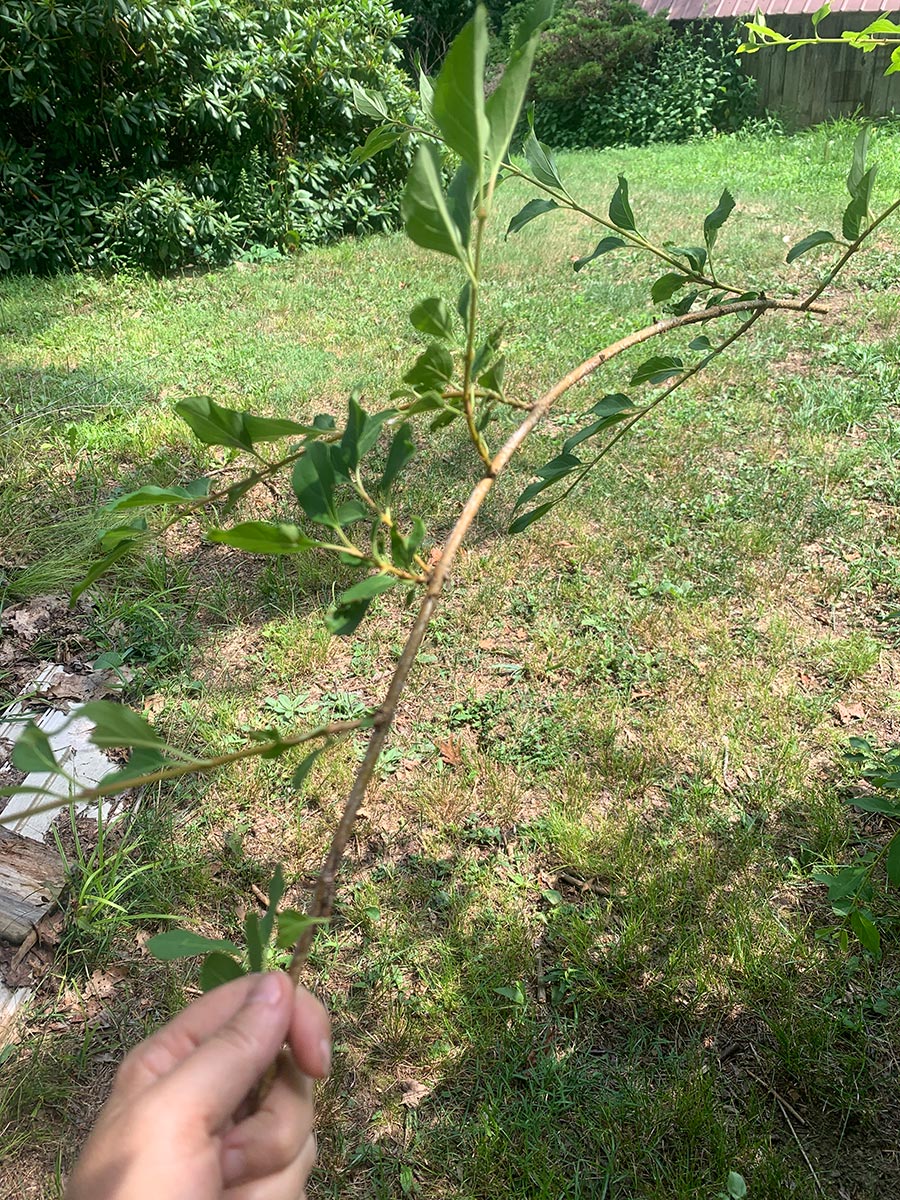 The next step is actually the most tricky and when you are most likely to break the branch. Slowly bend the woody material until it forms a head-shaped size (or a larger wreath size if you are making a garland instead). At this point, place it upon your own head to make sure it is not too big or too small and adjust accordingly, holding it in place so it doesn’t slip.
The next step is actually the most tricky and when you are most likely to break the branch. Slowly bend the woody material until it forms a head-shaped size (or a larger wreath size if you are making a garland instead). At this point, place it upon your own head to make sure it is not too big or too small and adjust accordingly, holding it in place so it doesn’t slip.
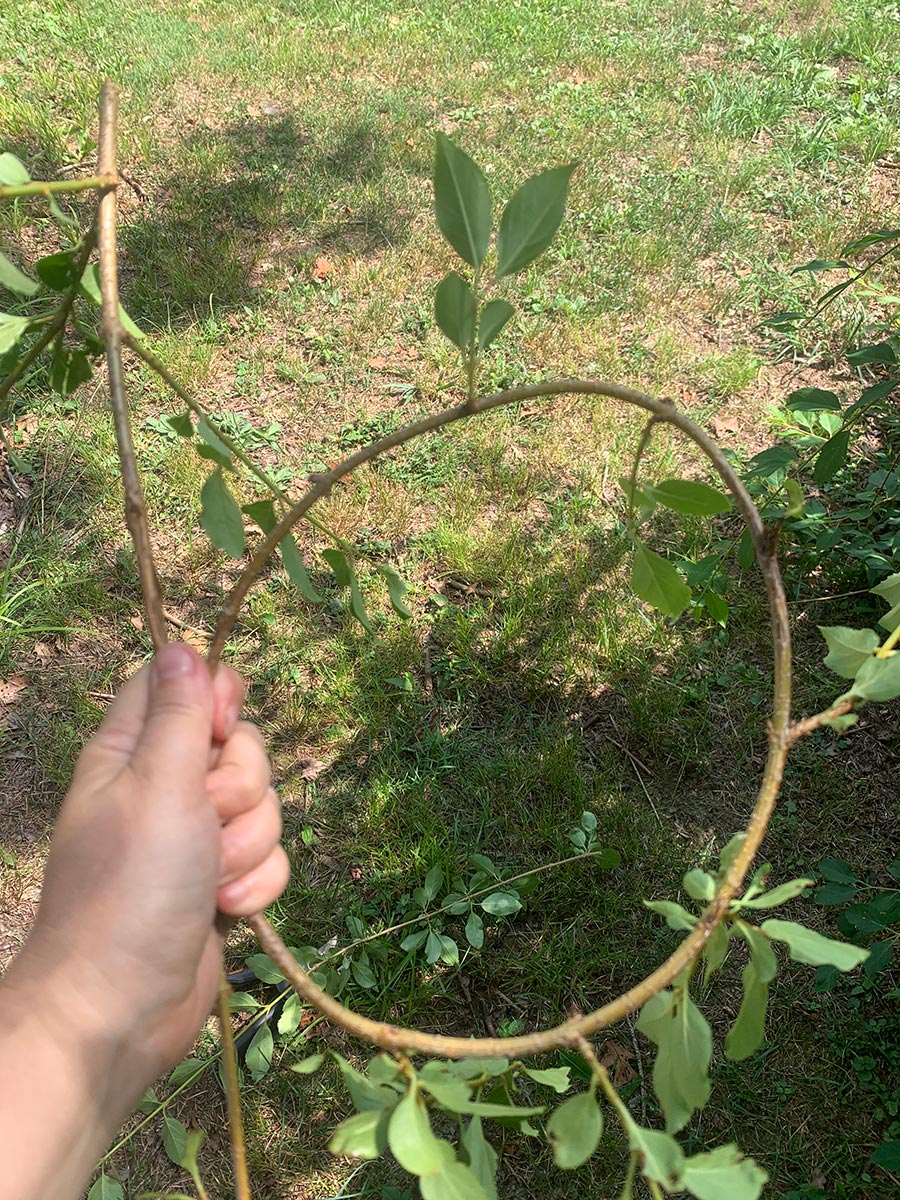 Next, keep weaving the branches through until the crown is solid and won’t shift. Usually, this can be accomplished by the 2nd or 3rd go around. In my case, I had a lot of extra smaller branches that were coming out of the main hydrangea stalk. I wove some of these in and cut some of them with pruners. Once you are at this stage, test the crown again and make sure it fits the shape of your head.
Next, keep weaving the branches through until the crown is solid and won’t shift. Usually, this can be accomplished by the 2nd or 3rd go around. In my case, I had a lot of extra smaller branches that were coming out of the main hydrangea stalk. I wove some of these in and cut some of them with pruners. Once you are at this stage, test the crown again and make sure it fits the shape of your head.
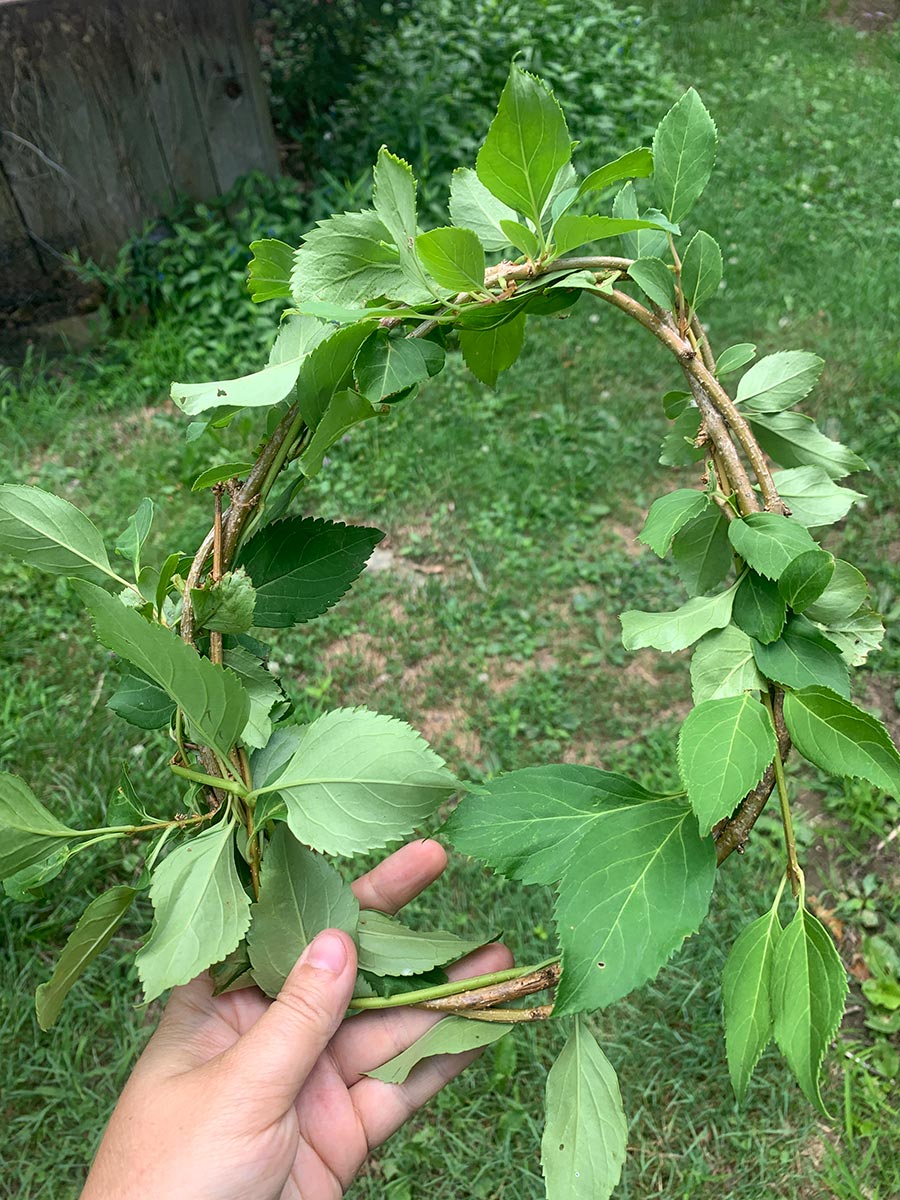 Now that you have your crown, it is time to gather flowers. You can gather them earlier and leave them in water. You want them as fresh as possible to go on your crown. At this stage, you can think about design–what do you want to include? How many flowers? do you want a big center flower or a bunch of flowers all around? Select what you will need.
Now that you have your crown, it is time to gather flowers. You can gather them earlier and leave them in water. You want them as fresh as possible to go on your crown. At this stage, you can think about design–what do you want to include? How many flowers? do you want a big center flower or a bunch of flowers all around? Select what you will need.
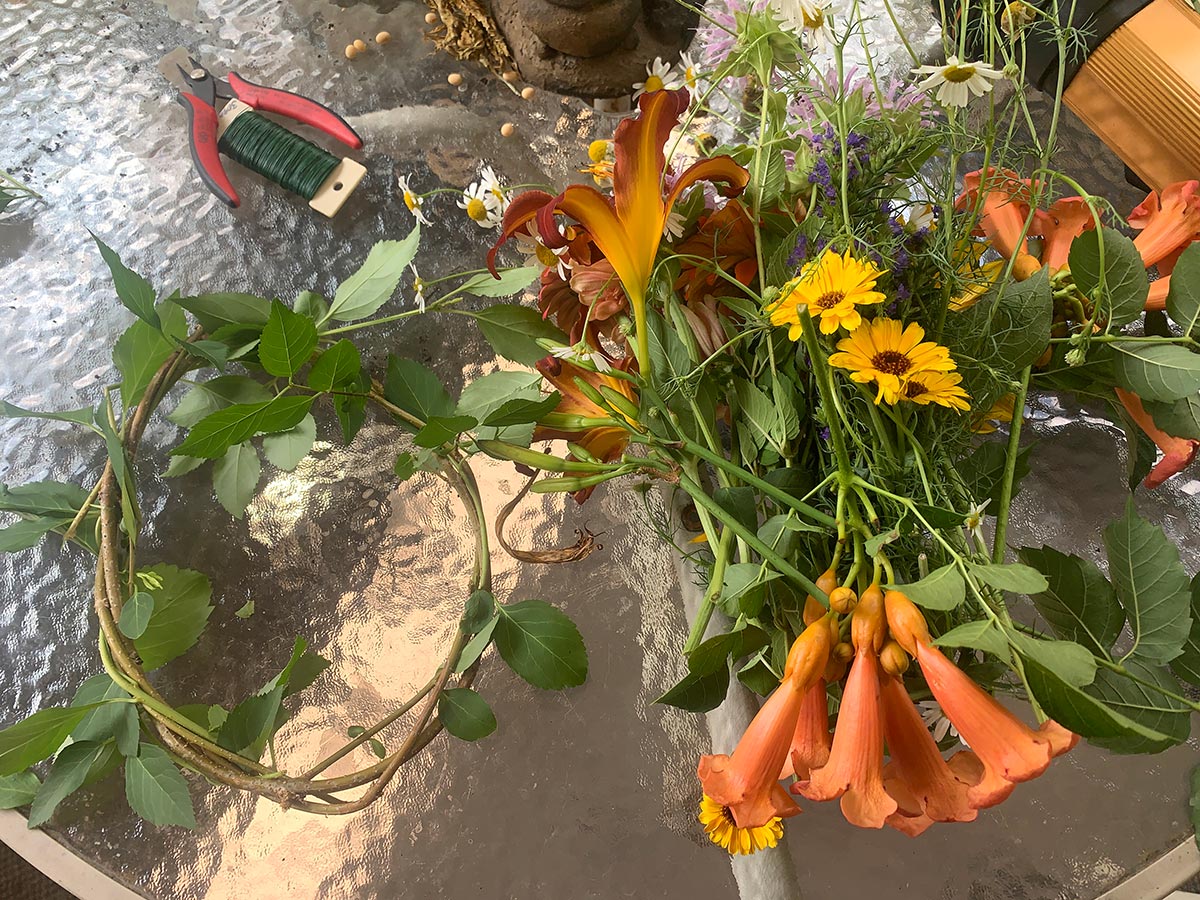 Here I am with my crown, flowers, and other tools ready to go!
Here I am with my crown, flowers, and other tools ready to go!
For making something to wear, you should probably use wire (I am using thin green floral wire) as it holds the crown in place better. But if you are leaving something to offer, I would not use a wire (which won’t break down and leave no trace) and instead use a natural hemp or cotton string for the flowers.
To construct your crown, lay your first flower and wiring or tie it to the crown. Then, lay your second flower where you tied or wired the first, and tie that one. Keep going around the crown, working to layer each flower and tie them. If you are wearing the crown, make sure you don’t make one side heavier than the other!
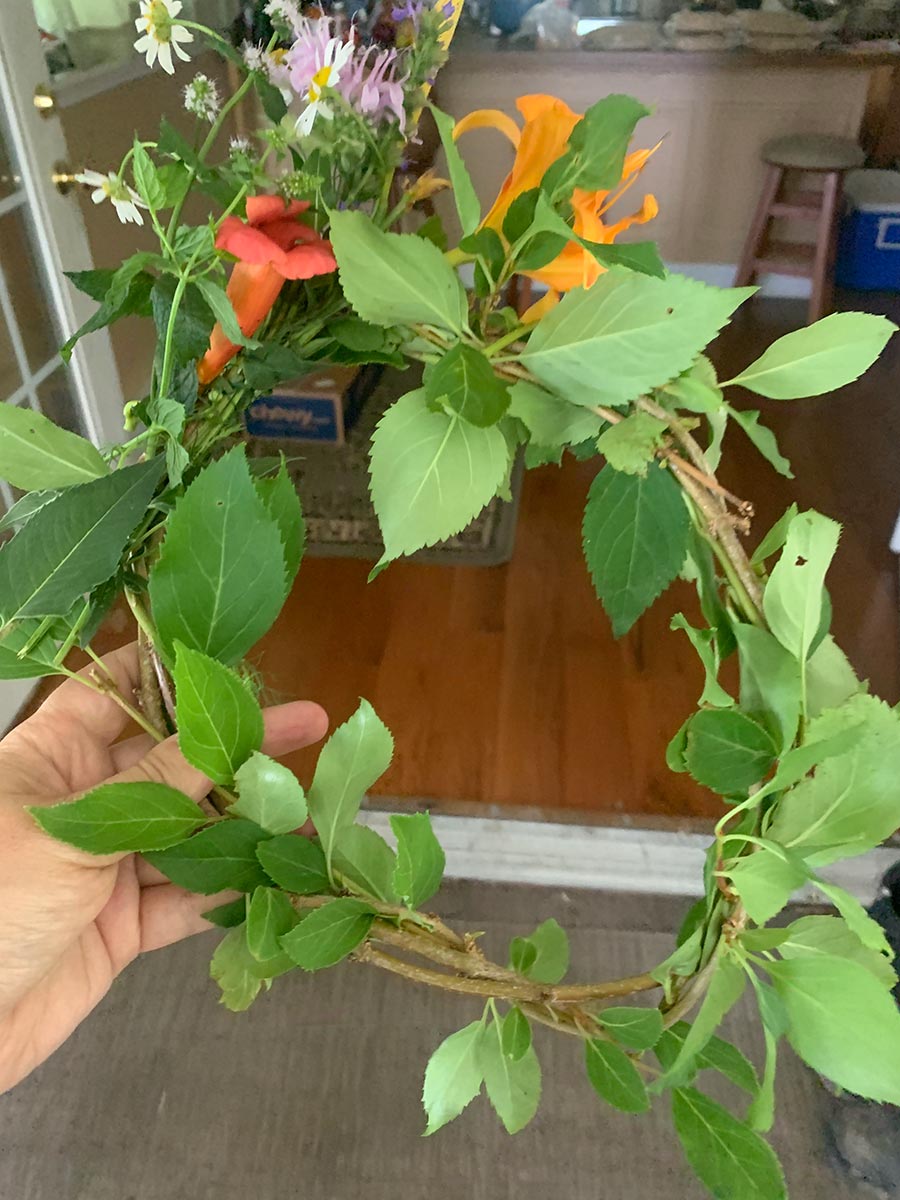 For this first crown, I left it mostly with greenery and wired only a few flowers. For the second crown (below) I added as many flowers as I could! Both have their charm. You can see what I mean about layering flowers here–just wire one in, lay the next on the previous wire, and work your way around the crown.
For this first crown, I left it mostly with greenery and wired only a few flowers. For the second crown (below) I added as many flowers as I could! Both have their charm. You can see what I mean about layering flowers here–just wire one in, lay the next on the previous wire, and work your way around the crown.
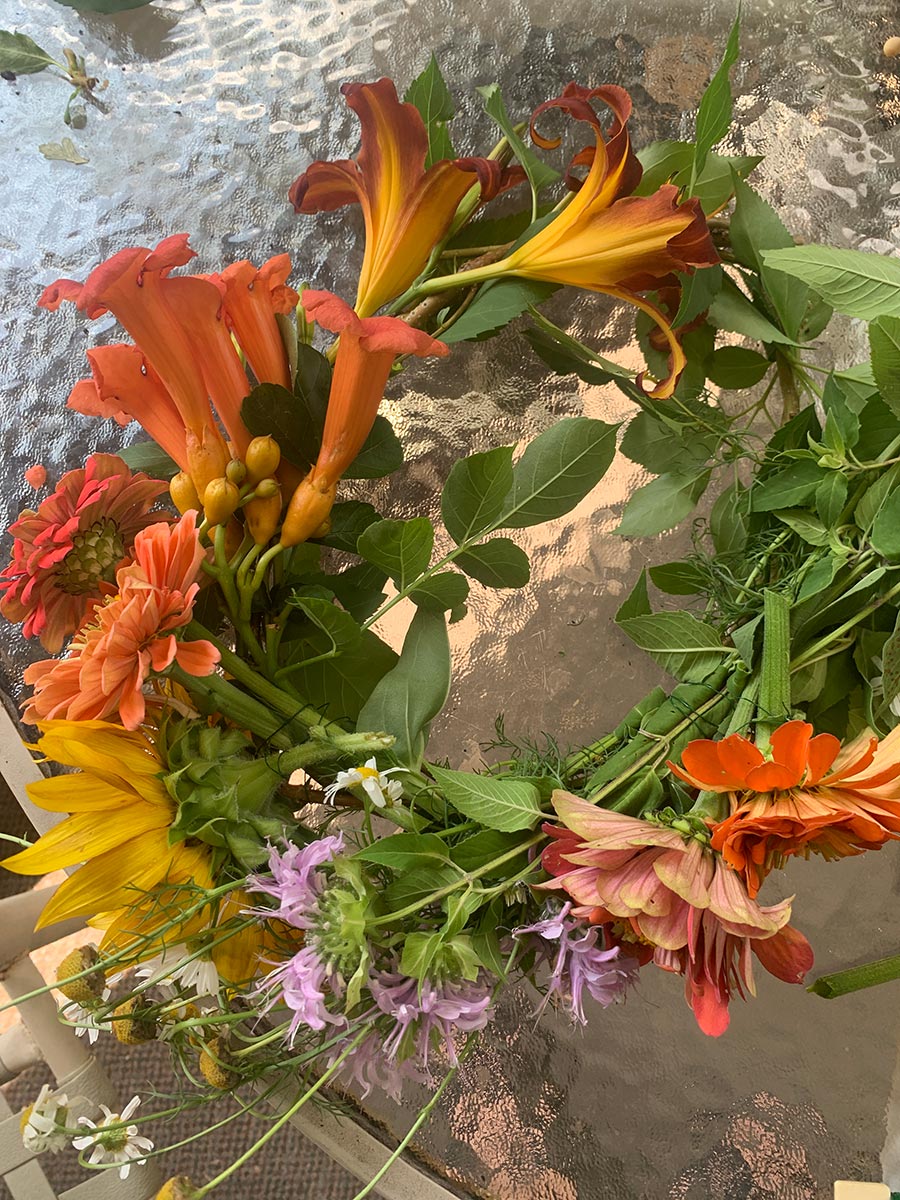 If you wanted to make a garland, the process is the same, just with a larger shape.
If you wanted to make a garland, the process is the same, just with a larger shape.
The other thing I want to share here is that you will have to work quickly if it is hot outside or your flowers will start to wilt. You might want to do a few practice crowns till you get the hang of things and can work quickly so that the flowers are fresh when you finish.
If you aren’t going to wear your crown right away, you can preserve it for at least 6-8 hours by wrapping it gently with some wet cloth or wet paper towels and putting it in a plastic bag and then sticking it in the refrigerator or a cooler. I was able to preserve several crowns for transport this way without any issue and they were still fresh hours after I made them. Once you start to wear it, depending on the heat of the day, it will likely look great for an hour–or several before it begins to seriously fade.
Ideas for your crowns and garlands
The uses of these crowns are wide-ranging. I have made them this summer as part of a personal ritual; the preparation for the ritual was gathering the materials and making the crown. I then proceeded to my ritual space and did my Lughnasadh ritual. Once druid gatherings and events get going again, I could see these very successfully being built into other rituals and experiences.
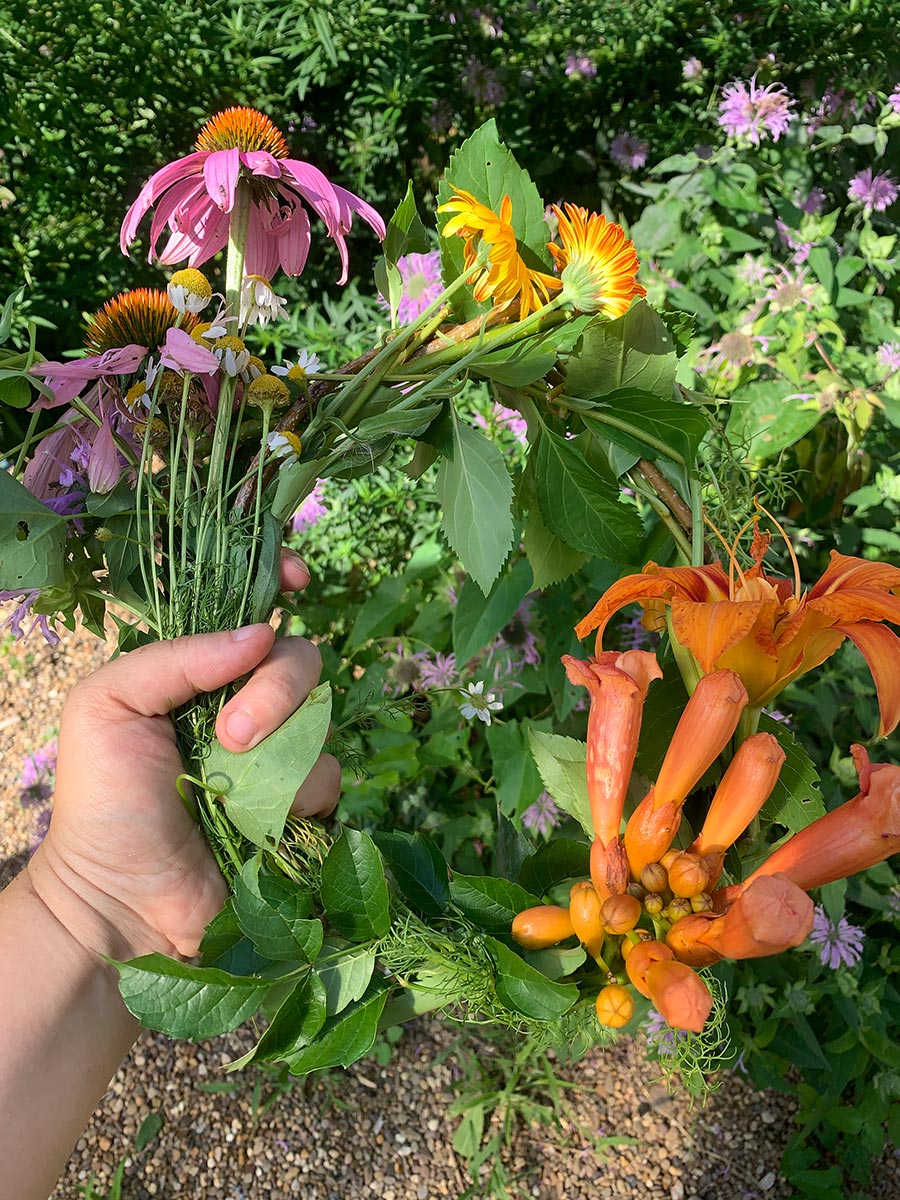 I have also used them as an offering at sacred places (like the opening suggests). I left a small braided bundle of herbs (a derivative of the crown idea) on the land that was being cut recently. I have left one within the grove of renewal that I have been working on regularly for land healing purposes. I have also visited my favorite sacred spring and tucked a small garland into the greenery behind the spring (lots of people visit it and I don’t know what they’d do with my garland if they found it!)
I have also used them as an offering at sacred places (like the opening suggests). I left a small braided bundle of herbs (a derivative of the crown idea) on the land that was being cut recently. I have left one within the grove of renewal that I have been working on regularly for land healing purposes. I have also visited my favorite sacred spring and tucked a small garland into the greenery behind the spring (lots of people visit it and I don’t know what they’d do with my garland if they found it!)
As I mentioned above, I made two very colorful ones (the ones that opened this post) for celebratory purposes–my sister was getting married and we wanted it to be extra special, especially since the pandemic has made everything more difficult. Those were very special crowns, and mementos that she can save, dry, and hang on a wall. It was a seriously wonderful and unique way to honor the bride and mother of the bride.
I hope that you have found this post inspirational, and yet another way that you can create sacred and meaningful things from your own druid’s garden!
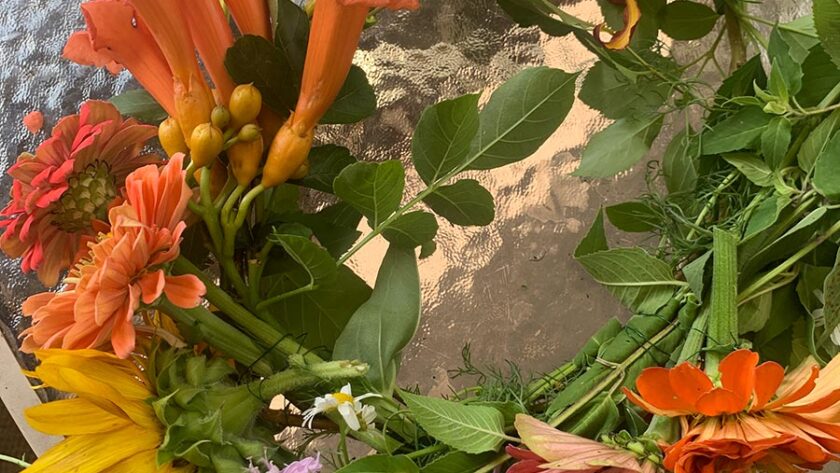


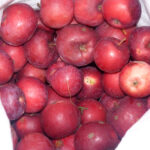
Reblogged this on Paths I Walk.
Reblogged this on Good Witches Homestead.
I love this reminder. Thank you for the inspiration! It’s so smoky here in the Pacific NW and I love dreaming of the vibrant flowers that will return next spring.
This is beautiful! Down here in Texas, in communities alive in Mexican culture, the tradition of flower crowns go back to Ancestral times, and are still a vibrant tradition for weddings and special holidays.
Tekina, thank you so much for sharing! That sounds wonderful. I’m so glad to hear of this tradition.
I was prunning some ground runner wisteria vines and made a garland from one. I wore it all day and felt like quite the faery queen. It lasted all day long without wilting. TY for sharing your magic. 🌟💫🌟🌧🌧🌧🌧
Maureen, that sounds wonderful! The Wisteria is such a pretty tree–we don’t have them around here, but I love them so much.
I love making flower crowns, I learned how to make them from my Latvian friends in college, many years ago. It is very popular to make them and wear them during summer. They do not use wire just weave daisy, herbs weeds and any other wild plants together into huge flower crowns. Young women, single women would traditionally wear them and men would wear oak crowns. This is especially popular during summer solstice when people come together to celebrate. It was a beautiful sight to see so many people wearing these gorgeous crowns, singing and jumping over the bonfire together. Flower crowns are a beautiful tradition that deserves a place in any nature spiritual tradition as well.
Wow! Thank you for sharing this wonderful tradition from Lativa! That sounds so amazing. Thank you for sharing!